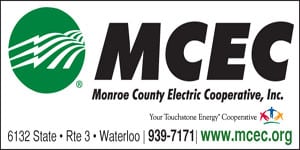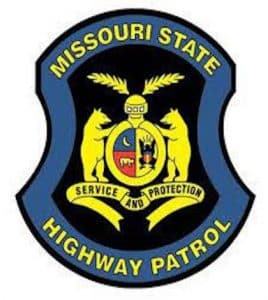OSHA mandate debate brews
The Occupational Safety and Health Administration is grabbing national headlines, but recent OSHA actions have caused concern locally as well.
Monroe County Health Department Administrator John Wagner said the federal organization is overstepping its bounds and he is not happy about it.
On Friday afternoon, Wagner sent several media outlets a copy of an OSHA letter dated Jan. 6 advising a Monroe County business of a complaint filed against it through the U.S. Department of Labor in OSHA’s Fairview Heights Area Office.
The complaint alleges employees of a small Columbia business are exposed to COVID-19 “due to the employer’s failure to enforce social distancing among workers or the use of face mask(s) in the workplace” and the “employer not sanitizing and disinfecting the workplace.”
Wagner said the complaint is “absolutely ridiculous” and an “overreach of OSHA.”
Wagner was upset that an alleged local health violation – usually the responsibility of a local health department – was even considered by the federal organization.
According to OSHA.gov, the group is responsible for “ensur(ing) safe and healthful working conditions for workers by setting and enforcing standards and by providing training, outreach, education and assistance.”
Wagner argued the complaint is “not in the realm of responsibility” of OSHA and as a “public health issue … involving a viral infection,” the complainant should have been referred to the Monroe County Health Department.
Wagner told the Republic-Times on Friday that the complaint against the Monroe County business is something that could “only happen in Illinois.”
“How can you target (businesses) in one state?” Wagner asked, pointing out that businesses in portions of neighboring Missouri where masking is not required would not be subject to a similar investigation by OSHA.
Wagner argued OSHA is now using its state offices to perpetrate an “intimidation tactic.”
According to OSHA’s letter, this business has until Jan. 13 to provide “documentation” of an investigation and “any necessary corrections or modifications” of “alleged conditions.” If the business does not respond by that date, it may become subject of an OSHA investigation.
The business, which Wagner described as a “mom and pop” employer with only a dozen or so employees, would not be subject to a recently issued OSHA mandate, he said, raising further questions about the sudden action of a federal entity in a local matter.
The mandate to which Wagner referred is OSHA’s “emergency temporary standard” COVID-19 policy requiring employers with more than 100 employees to develop a mandatory vaccine requirement or implement weekly testing for unvaccinated employees.
While intended for private businesses, the ETS will apply to local government employers in Illinois as well. The City of Waterloo, City of Columbia and Monroe County fall under the jurisdiction of Illinois OSHA through the Illinois Department of Labor.
Illinois OSHA announced Dec. 27 that it planned to follow federal OSHA’s guidance and require municipal employers with more than 100 employees to comply with the ETS mandate.
Last Monday, Columbia City Council grappled with how to proceed.
The input of Columbia Mayor Bob Hill and city aldermen directed Columbia City Administrator Doug Brimm to create a city ETS policy that does not require employee vaccination.
At the time, it was assumed Columbia and other similar municipalities would need to have OSHA-related policy in place by Jan. 10.
Since then, municipalities in Illinois with over 100 employees have a little breathing room for implementing policy.
The Illinois Department of Labor officially filed “peremptory rules to adopt the federal OSHA COVID-19 vaccination and testing emergency temporary standard” Jan. 7.
According to information on the IDOL website, those under Illinois OSHA have until Jan. 24 to develop an ETS-compliant policy and until Feb. 24 to implement the policy.
Implementation includes, in part, determining vaccine status of employees, providing support for employee vaccination, ensuring “employees who are not fully vaccinated wear face coverings when indoors or when occupying a vehicle with another person for work purposes,” and requiring employers to “promptly provide notice of positive COVID-19 test or … diagnosis.”
Employers who do not require vaccination must implement a system for weekly COVID testing of unvaccinated employees by March 25.
The ETS mandate for private, non-government employers with more than 100 employees still went into effect Monday morning as business owners are still waiting for a U.S. Supreme Court ruling about whether OSHA has the authority to implement its ETS requirement.
Oral arguments were heard in the nation’s highest court Friday regarding the ETS, which had originally been issued by OSHA on Nov. 5.
The Fifth U.S. District Court of Appeals stayed the policy until the stay was lifted Dec. 18 by the Sixth U.S. District Court of Appeals.
During arguments Friday, attorney Scott Keller argued on behalf of the National Federation of Independent Business and others that “OSHA’s economy-wide, one-size-fits-all mandate covering 84 million Americans is not a necessary, indispensable use of OSHA’s extraordinary emergency power.”
Justice Sonya Sotomayor asked why it would be unreasonable for “the federal government … (to) have a national rule that will protect workers?”
She argued that Congress, by passing the legislation that created OSHA, gave it authority to act in such matters.
Justice Samuel Alito pointed out that “most OSHA regulations … affect employees when they are on the job but not when they are not on the job. And this affects employees all the time. If you’re vaccinated while you’re on the job, you’re vaccinated when you’re not on the job. Isn’t this different from anything OSHA has done before in that respect?”
Justice Neil Goruch echoed comments from Chief Justice John Roberts in saying “Congress has had a year to act on the question of vaccine mandates already. As the Chief Justice points out, it appears that the federal government is going agency by agency as a workaround to its inability to get Congress to act.”
The Supreme Court also heard arguments on a challenge by 25 states to a Centers for Medicaid and Medicare Services vaccine mandate for all health care workers.
The CMS mandate is currently stayed in the states challenging the ruling. The mandate is in effect in Illinois, which did not challenge the CMS policy.
The U.S. Supreme Court released its decision Thursday on both workplace mandates.
The first ruling makes recent conversations about vaccine and testing requirements for local municipalities a moot point as fhe court voted 6-3 in favor of blocking the OSHA mandate.
Based on information he received Thursday from a “pre-eminent municipal firm” in Illinois, Brimm told the Republic-Times it appears as if Illinois OSHA adopted the “federal (rules) by reference,” meaning employers under Illinois OSHA would not need to implement the vaccine or testing policy.
Brimm added the Illinois Department of Labor has not yet released any guidance how employers should proceed based on Thursday’s decision, but he expects the state to follow federal precedent on the issue.
However, the Supreme Court voted 5-4 in favor of keeping a vaccine requirement for all medical employers who receive funds from the CMS. Medical businesses in states which challenged the order will now be obligated to adhere to the CMS requirement.








